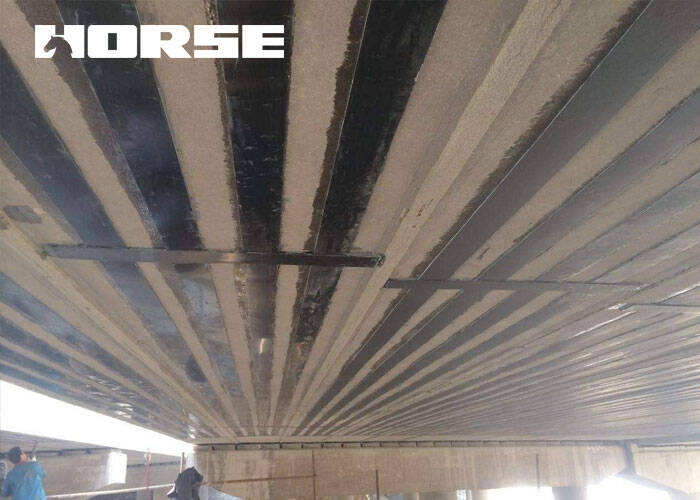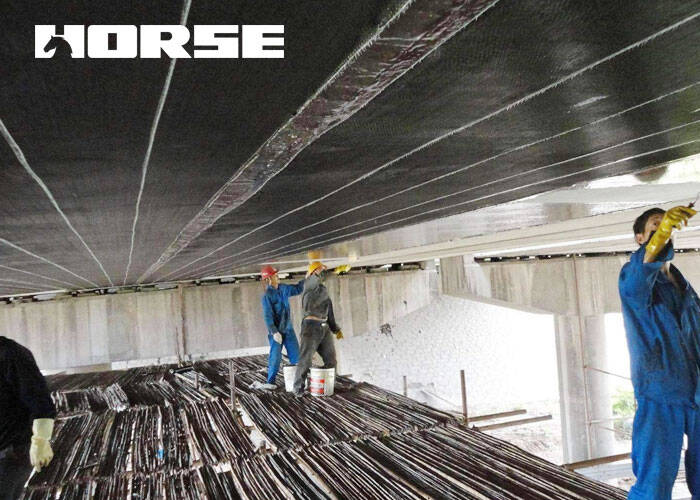Solutions
Horse Construction offers full range of structural strengthening materials with technical supports, documentation supports, products supports, project supports.
Carbon Fibre Bridge Strengthening

Design principles and methods of carbon fiber in bridge reinforcement
According to the basic design method of the project, the use of carbon fiber reinforced concrete structure is based on the following characteristics.
The cross section of the carbon fiber reinforced concrete bending member should be consistent with the erection of the plane deformation, and the strain of the steel bar and carbon fiber should appear in the same position as the concrete.
The stress-strain relationship of concrete, the strain of concrete under compression is generally through the use of the current standardized recommended model. In actual use, the pressure changes beyond the range that the material can withstand, the concrete structure is destroyed, and the strain change trend of the tensioned concrete becomes a linear change relationship. When the tensile stress exceeds its limit bearing capacity, the concrete structure will fail.
The concrete and carbon fiber structure will not slip during the strengthening process, and the structure should be simplified as much as possible. It can be approximated that the tensile strain basis of carbon fiber structure and steel bar is the same. According to the basic principle of equal force, the area of carbon fiber can be transformed into a steel structure of equal area.
Key points of carbon fiber bridge reinforcement
Carbon fiber should be installed under the tensile stress area of the force beam. If it must be pasted on the side of the beam, it should be limited to 1/4 of the beam height. The area of carbon fiber on the side must be multiplied by a reduction factor. The thickness of the carbon fiber paste does not exceed 5 layers. For the multi-layer carbon fiber structure, it is necessary to consider the reduction in the actual project. If there are too many layers, brittle lesions are prone to appear. The strength of the strip paste is higher than the strength of the entire paste. When pasting, the anchorage must be secured. The length is calculated.
Generally speaking, when strengthening the bridge slab, carbon fiber should be pasted on the beam side. The length of the connection between the fiber cloth should ensure the overlap, and the overlap is more than 10cm.
Basic principles of carbon fiber bridge reinforcement technology
Carbon fiber sheets have different tensile strengths due to the different arrangements of their internal structures. When the fiber direction of the carbon fiber sheet is the same as the direction of the force, the tensile performance of the basic structure is the best, and vice versa, the tensile performance is poor.
Generally speaking, the failure form of the component after bending is mainly due to the occurrence of cracks due to strong tensile stress in the transverse direction. After the carbon fiber material is added to the tension area of the component, the component will be subjected to a strong load. The cracks do not continue to expand, but the cracks in the middle of the span are gradually dispersed into small cracks, evenly distributed in the tension area. Carbon fiber can increase the strength of the entire component and can effectively prevent cracking of the pier structure. Due to insufficient transverse restraint stress, the strength of the pier column is reduced. At this time, if a carbon fiber sheet is added to the surrounding section of the main reinforcement or a carbon fiber sheet is wrapped around the pier column, it can effectively restrain the pier column and avoid its excessive deformation, thereby improving the seismic performance of the entire bridge.

Application advantages of carbon fiber cloth in bridge reinforcement engineering
1) Does not increase the load, does not affect the appearance of the structure
Carbon fiber cloth is lighter in weight, usually weighs less than 500g per square meter, and has a thickness between 0.2 and 0.3 mm. At the same time, the quality of the paste material is also very light, so it will not increase the load weight of the bridge, and the weight effect can be ignored. Furthermore, the use of carbon fiber cloth can be repeatedly pasted on a certain part, which is more flexible in reinforcement. After being pasted and fixed, since the paint is very thin, another layer of paint can be applied to the outer layer to maintain the integrity and aesthetics of the bridge.
2) Easy to shape, suitable for various shapes of components
When reinforcing irregular structural members, the use of traditional reinforcement methods will increase the difficulty of construction, while the use of carbon fiber cloth can adapt to the structural changes of the bridge. The construction is simpler and more flexible, and it can also reduce the cost of reinforcement, which is very applicable.
3) The construction is convenient and will not cause damage to the structure
The construction space of some bridges is very limited, and traditional reinforcement methods may cause local construction to be impossible. Carbon fiber cloth is more convenient and adaptable in construction. Carbon fiber cloth construction does not require the use of large templates, supports, fixtures, and is simpler in operation and less construction space. Usually, the adhesive material used is epoxy resin, and there is no need to excavate the bridge concrete, so it will not cause damage to the whole project.
4) Seal concrete cracks
Pasting carbon fiber cloth on the surface of concrete can seal concrete cracks, and its excellent performance can also restrain the further extension of concrete structure cracks and improve the problem of concrete cracks. Ensure the overall rigidity of concrete and improve the overall performance of the project.
5 Strong corrosion resistance
As a composite material with excellent performance, carbon fiber cloth will not be corroded due to the influence of natural factors, and its heat resistance is very outstanding. In actual use, in addition to being able to withstand the alkaline corrosion of cement, it can also maintain a longer life in a salt corrosive environment. It can be seen that the application of carbon fiber cloth is more practical in environments with many negative factors. .
Compared with traditional concrete structure reinforcement methods, carbon fiber materials are widely used in the bridge reinforcement process due to their high strength, convenient construction and strong durability. Carbon fiber reinforcement technology can ensure the durability and strength of the bridge structure, improve the safety of the bridge during its life cycle, and demonstrate the modern development trend.
You can find anything here you are in need of, have a trust trying on these products, you will find the big difference after that.

High strength carbon fiber reinforced polymer (CFRP) strip / laminate / plate for structural strengthening and concrete repair

Prestressed carbon fiber reinforced polymer(CFRP) plate for slab, beam strengthening to increase stiffness, reduce distortion and deflection of members, reduce the cracks, avoid and stop cracking.

High strength, unidirectional carbon fiber sheet pre-saturated to form a carbon fiber reinforced polymer (CFRP) sheet used to strengthen structural concrete elements.